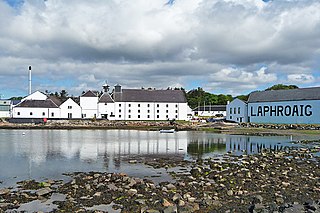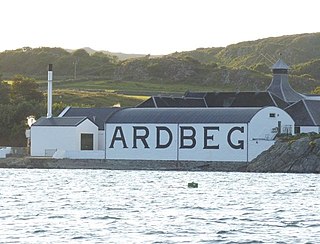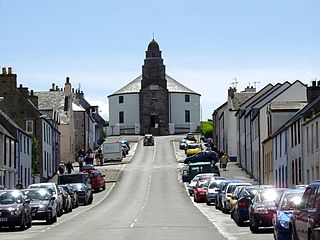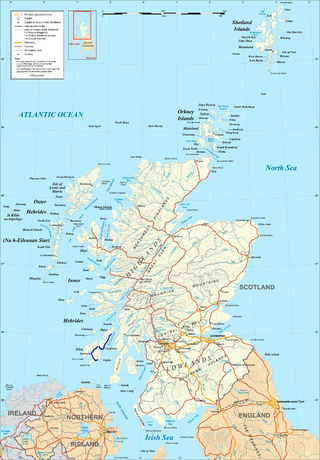
Scotch whisky, often simply called whisky or Scotch, is malt whisky or grain whisky made in Scotland.

Island single malts are the single malt Scotch whiskies produced on the islands around the perimeter of the Scottish mainland. The islands are not recognised in the Scotch Whisky Regulations as a distinct whisky producing region, but are considered to be part of the Highland region. Islay is itself recognised as a distinct whisky producing region.

Lagavulin distillery is an Islay single malt Scotch whisky distillery located in the village of Lagavulin on the south of the island of Islay, Scotland.

Lagavulin is a small village approximately 3 miles outside Port Ellen on the Isle of Islay, Scotland. The village is within the parish of Kildalton, and is situated on the A846 road.

Laphroaig distillery is a single malt Scotch whisky distillery on Islay, Scotland. It is situated on the south coast of the island, near Port Ellen, at the head of a small bay known as Loch Laphroaig. The Lagavulin and Ardbeg distilleries are close by.

Ardbeg distillery is an Islay single malt Scotch whisky distillery in Ardbeg on the South coast of the isle of Islay, Argyll and Bute, Scotland, in the Inner Hebrides group of islands.

Jura distillery is Island single malt Scotch whisky distillery located on the island of Jura in the Inner Hebrides off the West Coast of Scotland.

Bowmore is a small town on the Scottish island of Islay, situated on the banks of the sea loch, Loch Indaal. It serves as administrative capital of the island, and gives its name to the noted Bowmore distillery producing Bowmore single malt scotch whisky.

Bruichladdich Distillery is a distillery on the Rhinns of the isle of Islay in Scotland. The distillery produces mainly single malt Scotch whisky and The Botanist gin. Originally established in 1881 but closed many times throughout its history, its current form was opened in 2001. It has been owned by Rémy Cointreau since 2012.

Caol Ila distillery is a Scotch whisky distillery near Port Askaig on the isle of Islay, Scotland, owned by Diageo.

Port Askaig is a port village on the east coast of the island of Islay, in Argyll and Bute, Scotland. The village lies on the Sound of Islay across from Jura.

The A846 road is one of the two principal roads of Islay in the Inner Hebrides off the west coast of mainland Scotland and the only 'A' road on the neighbouring island of Jura.

Port Charlotte distillery is a inactive Islay single malt Scotch whisky distillery on the island of Islay, off the west coast of Scotland.
Tobermory Single Malt is a Scotch whisky distilled by the Tobermory Distillery, Tobermory on the Isle of Mull, a Hebridean island in western Scotland, north of the isle of Islay.

Islay is the southernmost island of the Inner Hebrides of Scotland. Known as "The Queen of the Hebrides", it lies in Argyll and Bute just south west of Jura and around 40 kilometres north of the Northern Irish coast. The island's capital is Bowmore where the distinctive round Kilarrow Parish Church and a distillery are located. Port Ellen is the main port.
The idea of drinking whisky with food is considered outré by many, but there is a growing interest in pairing whiskies with complementary foods. The Scotch whisky industry has been keen to promote this. Single malts, pot-still whiskies, bourbons, and rye whiskies offer an interesting range of tastes and aromas, which are just as varied as wine. Jake Wallis Simons compares whiskies in bourbon casks to white wines, due to their lighter flavor, and those in sherry casks to red wines, with their greater fruitiness. A few Scottish cook books contain reference to the use of whisky in cooking, and a few traditional Scottish recipes that use whisky exist.

Ardbeg is a small settlement on southern coast of the island of Islay, in the council area of Argyll and Bute, off the west coast of Scotland. It is around 3 miles east of Port Ellen and 1 mile northeast of Lagavulin at the eastern terminus of the A846 road.
Douglas Laing & Co is an independent bottler of Scotch whisky. Based in Glasgow, Scotland and established in 1948, the company has a number of brands including its "Remarkable Regional Malts" range, encompassing The Epicurean, Timorous Beastie, Scallywag, Rock Island and Big Peat, as well as Old Particular, Provenance and Xtra Old Particular, which they collectively call their "Exceptional Single Casks". The firm also creates and sells King of Scots Blended Scotch Whisky, Clan Denny Single Casks and Premier Barrel.

Bunnahabhain distillery was founded in 1881 near Port Askaig on Islay and is owned by the Scotch whisky producer Distell Group Limited a subsidiary of Heineken N.V,. The village of Bunnahabhain was founded to house its workers.

Ardnahoe distillery is a Scotch whisky distillery on Islay, in Scotland.























